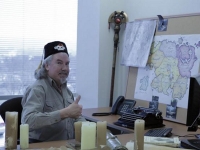Lifestyle
Reminiscing About White Plume Mountain
A few words with Lawrence Schick

Lawrence Schick 1 (Source: Lawrence Schick)
While working on a review for the 5th Edition Dungeon Master´s Guide I discovered that some of the items placed within came from one of my favorite 1st Edition Dungeons and Dragons adventures. White Plume Mountain was a great dungeon crawl with powerful artifacts that every player wants for their very own.
I played this adventure at Gen Con back in 1979 or 1980 and it left a lasting impression on me and my own personal gaming style. I think that over the years, I have heard more than a hundred players claim they wanted Blackrazor, the soul stealing sword, for their very own. I personally would have tossed that cursed artifact into a volcano.
I played this adventure at Gen Con back in 1979 or 1980 and it left a lasting impression on me and my own personal gaming style. I think that over the years, I have heard more than a hundred players claim they wanted Blackrazor, the soul stealing sword, for their very own. I personally would have tossed that cursed artifact into a volcano.
I always felt that the module was missing some grand story. As with so many of those early adventures, the story was up to you to create but the module gave you the basis of a framework to kick-start you in the right direction. Perhaps this is the true reason that Dungeons and Dragons has proven so successful over the past 35+ years.
I decided to contacted Lawrence Schick, the author who penned White Plume Mountain in order to discover how the story came to be. Mr Schick works for ZeniMax Online and is one of the key designers of the Elder Scrolls Online. I can promise you that I was surprised to discover one of my tabletop RPG icons had transitioned to working on what may be, the best PC RPG that has been made.
I decided to contacted Lawrence Schick, the author who penned White Plume Mountain in order to discover how the story came to be. Mr Schick works for ZeniMax Online and is one of the key designers of the Elder Scrolls Online. I can promise you that I was surprised to discover one of my tabletop RPG icons had transitioned to working on what may be, the best PC RPG that has been made.
Mr. Schick received my request and was open to a brief conversation the text of which follows:
Q: How did you come to work for TSR?
A: In 1978, TSR advertised for a design position. I went to one of their smaller Lake Geneva conventions to talk to them about it, and Gary Gygax asked me to write an AD&D scenario as an example of my work. I took my best ideas from five years of designing dungeons, put them together as White Plume Mountain, and sent it in. That got me the job, and Gary decided to publish it as a module without changing a line.
Q: How did you come to work for TSR?
A: In 1978, TSR advertised for a design position. I went to one of their smaller Lake Geneva conventions to talk to them about it, and Gary Gygax asked me to write an AD&D scenario as an example of my work. I took my best ideas from five years of designing dungeons, put them together as White Plume Mountain, and sent it in. That got me the job, and Gary decided to publish it as a module without changing a line.
Q: What was the best memory you have of your time with TSR?
A: My best memory is of collaborating with Zeb Cook on the original Star Frontiers rules. That was the most challenging task I had during my time at TSR.
Q: I read some years ago that you never intended White Plume Mountain to be published. That being said, what changes would you make to the story if you rewrote it today?
A: I would certainly give it a more coherent backstory and make the dungeon more organically sensible. As it stands it´s just kind of a funhouse, a series of interesting challenges without much in the way of context.
A: My best memory is of collaborating with Zeb Cook on the original Star Frontiers rules. That was the most challenging task I had during my time at TSR.
Q: I read some years ago that you never intended White Plume Mountain to be published. That being said, what changes would you make to the story if you rewrote it today?
A: I would certainly give it a more coherent backstory and make the dungeon more organically sensible. As it stands it´s just kind of a funhouse, a series of interesting challenges without much in the way of context.
Q: Erol Otus is the elusive man who did the artwork for the original White Plume Mountain. What can you tell me about him?
A: Erol´s art is important to the history of D&D because he, more than any other of the early TSR artists, captured some of the transgressive glee that was part of early dungeoneering. D&D gave players permission to kill people and creatures and then take their stuff, just because the opponents were “monsters.“ Erol´s drawings depicted the darkly comic side of D&D.
A: Erol´s art is important to the history of D&D because he, more than any other of the early TSR artists, captured some of the transgressive glee that was part of early dungeoneering. D&D gave players permission to kill people and creatures and then take their stuff, just because the opponents were “monsters.“ Erol´s drawings depicted the darkly comic side of D&D.
Q: Out of all of the people you have worked with in the gaming world, who inspired you the most?
A: Designing games for Gary Gygax was certainly very inspiring, but I´d have to say that working with Sid Meier at MicroProse was even more influential. Gary taught me how to make complicated games; Sid taught me how to make simple ones.
Q: I assume you have kept up with the various changes to Dungeons and Dragons. Do you have any opinions on the later editions?
A: I like the general feel of the new 5th edition quite a bit, though I haven´t had an opportunity to really put it through its paces yet. From a design standpoint, parts of it are quite elegant.
A: Designing games for Gary Gygax was certainly very inspiring, but I´d have to say that working with Sid Meier at MicroProse was even more influential. Gary taught me how to make complicated games; Sid taught me how to make simple ones.
Q: I assume you have kept up with the various changes to Dungeons and Dragons. Do you have any opinions on the later editions?
A: I like the general feel of the new 5th edition quite a bit, though I haven´t had an opportunity to really put it through its paces yet. From a design standpoint, parts of it are quite elegant.
Q: You have made the transition from tabletop gaming to online gaming. Why don´t you tell me a little about that transition?
A: Mike Stackpole and Jennell Jaquays deserve the credit for that: they were the first paper-game designers to move over to video games when they went to work for Coleco in 1981. They gave me a call after I left TSR, and I decided to give it a try, even though I had no experience with programming. However, it turned out the skills needed to design a board game or RPG map directly onto the task of computer game design. I´ve been doing it ever since.
A: Mike Stackpole and Jennell Jaquays deserve the credit for that: they were the first paper-game designers to move over to video games when they went to work for Coleco in 1981. They gave me a call after I left TSR, and I decided to give it a try, even though I had no experience with programming. However, it turned out the skills needed to design a board game or RPG map directly onto the task of computer game design. I´ve been doing it ever since.
Q: What game are you currently working on?
A: I´m currently employed by ZeniMax Online, a Bethesda Software company, where I´m a writer and the “Lead Loremaster“ for The Elder Scrolls Online.
Q: Can you tell us any secrets about The Elder Scrolls Online?
A: Nope. The Marketing Department wouldn´t like me stepping on their toes!
Q: What gaming conventions do you regularly attend?
A: I usually find my way to GenCon in the summer, as well as to other, smaller conventions in the Mid-Atlantic region.
A: I´m currently employed by ZeniMax Online, a Bethesda Software company, where I´m a writer and the “Lead Loremaster“ for The Elder Scrolls Online.
Q: Can you tell us any secrets about The Elder Scrolls Online?
A: Nope. The Marketing Department wouldn´t like me stepping on their toes!
Q: What gaming conventions do you regularly attend?
A: I usually find my way to GenCon in the summer, as well as to other, smaller conventions in the Mid-Atlantic region.
Q: Is there anything I failed to ask that you want to share?
A: If you want to become a game designer for video games, study tabletop board games and RPGs, because their game mechanics are all right there on the surface; you can see all their systems, tinker with variations, and analyze what works and what doesn´t.
As you can see, Mr Schick has taken what started out as a fun gambit to score him a job and turned it into a very interesting career. I feel certain that the future of the Elder Scrolls Online is in great hands.
A: If you want to become a game designer for video games, study tabletop board games and RPGs, because their game mechanics are all right there on the surface; you can see all their systems, tinker with variations, and analyze what works and what doesn´t.
As you can see, Mr Schick has taken what started out as a fun gambit to score him a job and turned it into a very interesting career. I feel certain that the future of the Elder Scrolls Online is in great hands.
Liability for this article lies with the author, who also holds the copyright. Editorial content from USPA may be quoted on other websites as long as the quote comprises no more than 5% of the entire text, is marked as such and the source is named (via hyperlink).






